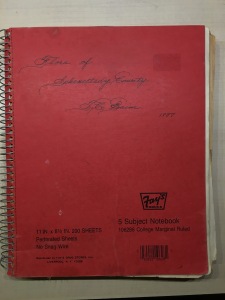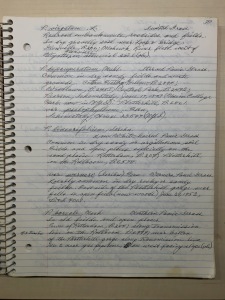Adiantum pedatum Maidenhair Fern
In rich moist woods, slopes of ravines and wooded hillsides. Cotton Factory Hollow, Baim 1226; Plotterkill, Baim 1898, Glenville, Baim 4861.
Anchistea virginica Virginia Chain Fern
Rotterdam in swamp, Whitney 4905 (NYS). In Sphagnum bog south of the New York Central Railroad near Albany County line, Baim 3008.
Asplenium platyneuron Ebony Spleenwort
In dry open woods, lower end of Wolf Hollow, Baim 1117; northwest corner of the Town of Glenville, in thin soil on limestone, Baim and Edgar 1934; on dry shale, Aqueduct, Rev. E.J. Cummings (NYS).
Asplenium rhizophyllum Walking Fern
On shale and sandstone ledges and adjacent wooded slope of the Plotterkill gorge, Baim 38; on limestone and talus in Wolf Hollow, Baim 1940; Hoffmans, E.J. Wheeler, June 13, 1908 (NYS).
Asplenium ruta-muraria Wall-rue Spleenwort
Rare in Schenectady County. On limestone ledges in Wolf Hollow, Baim 1944; Hoffmans, E.J. Wheeler, Oct. 2, 1909 (NYS).
Asplenium trichomanes ssp. trichomanes Maidenhair Spleenwort
On moist shale ledges along the Plotterkill gorge, Baim 1861; Duanesburg, H.M. Denslow (NY); on limestone ledges and mossy talus in Wolf Hollow, Baim observation.
Athyrium angustum Lady Fern
Common in rich moist woods, in swampy places, occasionally in open places. Plotterkill, Baim and Northrop 24, Baim 6822; Cotton Factory Hollow, Baim 1592; Rotterdam, Baim 1180; Taylor Pond, Glenville, House Sept. 19, 1926 (NYS); Stanford Heights, Niskayuna, Baim 3638.
Botrychium angustisegmentum Lance-leaved Grape Fern
Open woods in damp sandy loam. Stanford Heights, Niskayuna, Baim 3992 & 4672.
Botrychium dissectum Grape Fern
Infrequent but distributed throughout the county in rich, damp woods. Rotterdam, Baim 9. Forma obliquum (Muhl.) Fern. The more common form. Plotterkill, Baim 1920; Niskayuna, Baim 4303.
Botrychium matricariifolium Matricary Grape Fern
In rich damp woods and thickets. Not common. Niskayuna, Baim 3991; Plotterkill, Baim and Edgar 1730. In the Plotterkill location several hundred individuals of this species were found covering an area of 4 or 5 square meters on June 23, 1946.
Botrychium multifidum Leathery Grape Fern
In dry sandy woods and thickets among pitch pine and scrub oak, Woodlawn, Baim 10 and 2812. South Schenectady in sandy pine woods, Baim 3938 and 3954. The above localities have been destroyed by housing developments.
Botrychium virginianum Rattlesnake Fern
More or less common in rich moist woods. Plants up to one meter long are found in the lower end of the Plotterkill Ravine. Plotterkill, Baim 1731.
Cryptogramma stelleri Slender Cliff-brake
Hoffmans, E.J. Wheeler, June 8, 1907 (NYS).
Cystopteris bulbifera Bladder Fern
Locally common on damp ledges and in moist shaded places along ravines. Plotterkill, Baim 717; Hoffmans, E.J. Wheeler, June 13, 1908 (NYS).
Cystopteris fragilis Brittle Fern
On damp or dry shaded ledges and rock outcrops along ravines of the Rotterdam and Glenville hills. Plotterkill, Baim 1859; Schenectady, Dr. Allen Dedrick 1844 (La)
Dennnstaedtia punctilobula Hay-scented Fern
In dry or moist soil of open places, sandy banks and open woods. Wolf Hollow, Baim 1046; Niskayuna, Baim and Edgar, 1785; Plotterkill, Baim 6841; dry open woods, Hoffmans, E.J. Wheeler, Oct. 2, 1909 (NYS).
Deparia acrostichoides Silvery Spleenwort
In rich moist woods and along ravines. Taylor Pond, Glenville, House 13445; Wolf Hollow, Baim 1943; Vale Cemetery, Baim 2041; east end of the Crabbe Kill, Glenville, Baim observation; Plotterkill, Baim 6973.
Dryopteris carthusiana Common Wood Fern
Common in rich damp woods, wooded swamps and in ravines. Vale Cemetery, Baim 2368; Central Park, Schenectady, Baim 2496; Plotterkill, Baim 6789; Stanford Heights, Baim 3280, 3704. var. intermedia (Muhl.) Morton, Plotterkill, Baim 11; Niskayuna, Baim 3704. var. fructuosa (Gilbert) Morton, Niskayuna in swampy woods, Baim 5142.
Dryopteris goldiana Goldie’s Fern
In wet woods and on talus. Wolf Hollow, Baim 1211; Hoffmans, E.J. Wheeler, January 13, 1908 (NYS); in swampy woods bordering the upper end of the Crabb Kill, Glenville (obs.)
Dryopteris marginalis Marginal Wood Fern
Common in dry rocky woods and on ledges and outcrops along ravines. Plotterkill, Baim 15.
Dryopteris x bootii Boott’s Wood Fern
(D. cristata x austriaca var. intermedia) In wet alder thicket on farm of Warren Martin, Niskayuna, Baim and Edgar 2000; Three miles west of Mariaville, S.J. Smith (obs.).
Gymnocarpium dryopteris Oak Fern
In cool moist woods and along ravines. Plotterkill, Baim 19 and Baim 1061; in ravine south of Rotterdam Junction, Baim 1196; formerly in Cotton Factory Hollow, Baim observation; Vale Cemetery ravine, Baim observation.
Homalosorus pycnocarpos Narrow-leaved Spleenwort
Wolf Hollow in thin moist humus, Baim 1210.
Matteuccia struthiopteris var. pensylvanica Ostrich Fern
In alluvial soil along the Mohawk River, in swamps, moist woods and in springy places. South side of railroad near the Plotterkill, Baim 7U; Woodlawn, Baim 2404, Stanford Heights, Baim 6677.
Ophioglossum vulgatum Adders-tongue Fern
Formerly abundant in low wet grassy depressions, 1/4 mile west of Kings Road in Woodlawn. Baim 734 and 3002. Locality destroyed in 1950.
Osmunda claytoniana Interrupted Fern
In damp woods, swamps and wet meadows. Cotton Factory Hollow, Baim 705.
Osmunda regalis var. spectabilis Royal Fern
Locally common in wet woods and wooded swamps. Plotterkill Preserve, Baim 710. Forma anomalis (Fern.) Harris, Stanford Heights, Baim 3320. Forma orbiculata Clute, Stanford Heights, Baim 4148.
Osmundastrum cinnamomeum var. cinnamomeum Cinnamon Fern
Common in moist woods and swampy places. Cotton Factory Hollow, Baim 704. Stanford Heights, Baim 3664. Forma bipinnatifida Clute, Cotton Factory Hollow, Baim 2896.
Pellaea atropurpurea Purple Cliff-brake
On limestone ledges in Wolf Hollow, Baim 1118.
Phegopteris connectilis Long Beech Fern
In rich damp woods and along ravines. Vale Cemetery near Nott Terrace, Baim 1946 and Baim 2847; Cotton Factory Hollow, Baim 5525 and Baim 5822; Wolf Hollow, Baim 4534; Featherstonhaugh Lake, Baim 6471.
Phegopteris hexagonoptera Broad Beech Fern
Woods in rich moist or dry soil. Bottom of Plotterkill Gorge, Baim 1896; north of Rynex Brook, Plotterkill Preserve, Baim observation; north slope of Yantapuchaberg, Baim 20; in wooded swamp east end of the Crabb Kill, Glenville, Baim 4860; Taylor Pond, Glenville, House 13448 (NYS); Rotterdam, east of the Plotterkill, Baim 3864.
Polypodium virginianum Common Polypody
On slopes of ravines, rock outcrops and ledges. Plotterkill, Baim 40; Verf Kill, Baim 2842; Wolf Hollow, Baim observation.
Polystichum acrostichoides Christmas Fern
Common in dry or damp rocky woods, and on wooded slopes of ravines. Plotterkill, Baim and Northrop 1; Wolf Hollow, Baim 3136, Cotton Factory Hollow, Baim 4408; Plotterkill, Baim 6936; Stanford Heights, Baim 3328. Forma incisum (Gray) Gilbert, rock slope of ravine, north base of Yantapuchaberg, Rotterdam, Baim 3. Forma cristatum Clute, Niskayuna near Lock 7, Baim 5009; in rich moist woods.
Pteridium aquilinum ssp. latiusculum Braken Fern
Common in dry rocky woods, thickets and open places.
Thelypteris noveboracensis New York Fern
In moist woods and thickets. Plotterkill, Baim 1039; Cotton Factory Hollow, Baim 1593; Vale Cemetery, Baim observation; locally abundant in rich damp woods, Stanford Heights, Baim observation.
Thelypteris palustris Marsh Fern
Common in moist woods, swamps, border of ponds and in wet ditches. Rotterdam, Baim 16; Woodlawn, Baim 3862; Plotterkill, Baim 6865. Forma pufferae (A.A. Eat.) Prince, Stanford Heights, Baim 5118; swampy woods in Niskayuna, Baim 5144.
Thelypteris simulata Massachusetts Fern
Border of wooded swamp, Stanford Heights, Baim 3945.
Woodsia obtusa Common Woodsia
Wolf Hollow on limestone ledges, Baim 1945.

